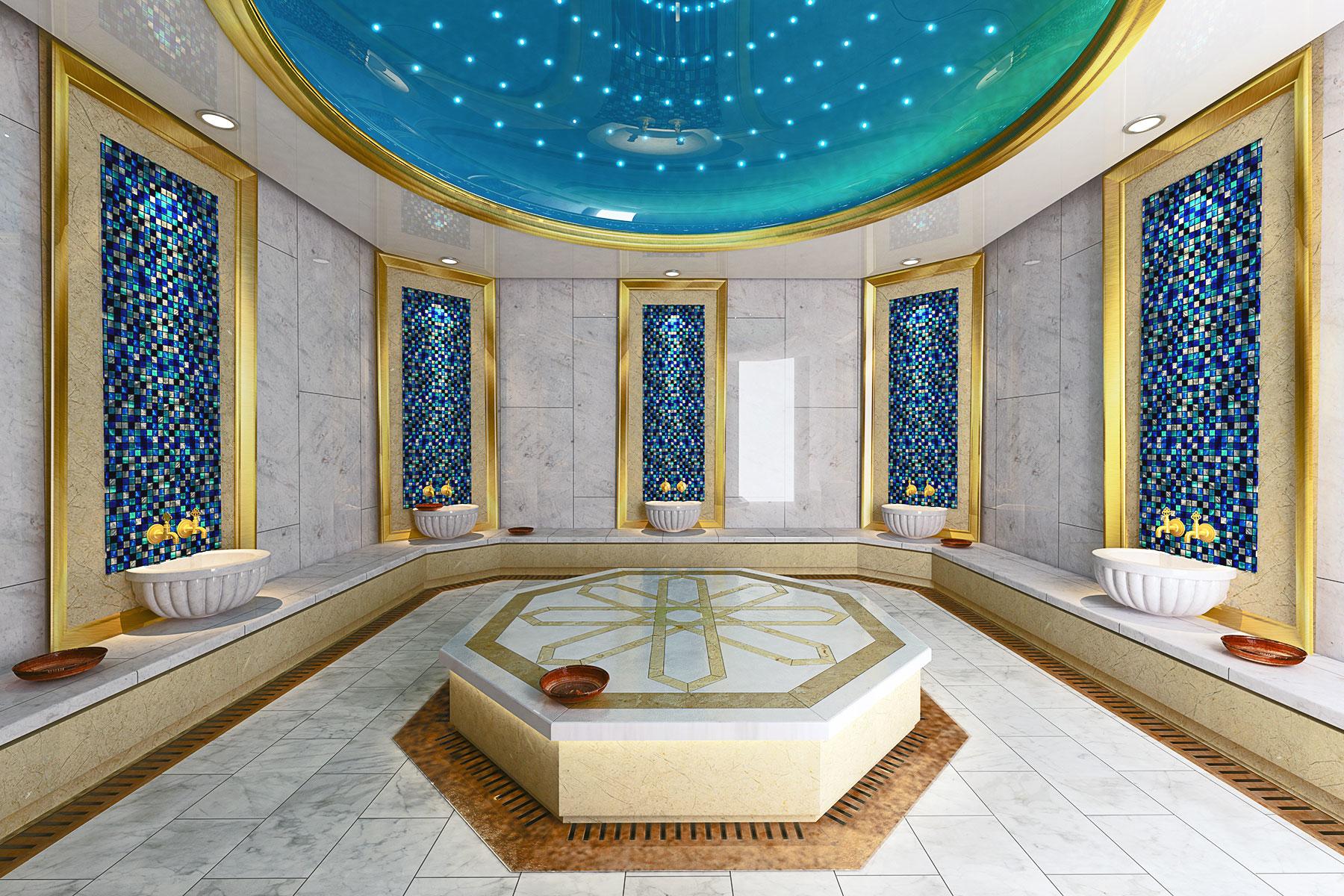Everything you need to know but are too shy to ask.
The Turkish hamam (ḥammām in Arabic) is an ancient ritual. It traditionally takes place in a centuries-old building with a beautiful domed ceiling, often with stars cut out of it. The daylight filters through the steam, making the experience even more magical.
What takes place there, is a combination of Roman, Byzantine, and Central Asian baths. The Turkish style includes the exfoliation typical of hamams in northern Africa, but differs in a few ways, most noticeably in a massage with a pile of whipped cream-like soapy bubbles.
You’ll wish you were allowed to bring your camera in to snap a few photos. Instead, you’ll have to settle for a mental picture. As with most ancient rituals, the Turkish bath has etiquette to be aware of. And whenever taking your clothes off in public is involved, you want to make sure you know the rules. Here’s everything you need to know to try a Turkish hamam with confidence.
How to Choose a Hamam
Depending on the size of the Turkish city you’re in, you might have several hamams to choose from. In larger cities like Istanbul, you’ll find hamams that cater mostly to tourists and hamams that cater almost exclusively to local residents, and hamams that are somewhere in between. There are even hamams that are technically full-service (expensive) spas that include a hamam component.
Your experience at each hamam will vary. At hamams catering to locals, trying to communicate with Turkish-speaking staff may be awkward but they’ll likely have the best quality scrubs and massages and your experience will be more memorable. Hamams that cater to tourists will be more used to communicating with tourists who don’t speak Turkish. But, as with all services aimed at unwitting tourists who are unlikely to return, prices will be high and the service will be mediocre. At the spa-type hamams, you’ll pay the most, and your service will be somewhat westernized though quite good.
Your best bet? Seek advice from your hotel, or look for the middle ground: a smaller, one-hamam town that receives some tourist traffic.
What Are the Different Service Options?
Your options range from self-service to full-service including massage, or you can pick something in between. Spas catering to westerners will likely have a menu to choose from, usually with a range of massage options.
Unless you have the luxury of going regularly to a hamam and know what you’re doing, opt for the full-service traditional style. It includes warming up in a hot room, a very thorough scrub and soaping, and an optional massage where you’ll be stretched and bent like a pretzel.
If you choose the self-service option, you’re just buying access to the facilities. You’ll be expected to wash yourself and will you’ll usually need to bring all your own supplies including soap, bowl, towel, and scrub mitt.
Recommended Fodor’s Video
Arriving at the Hamam
The first thing you’ll do is choose your service and pay when you enter. If you choose the full-service option, you’ll be given some supplies either at the reception desk or in the dressing room. Some may be provided inside the hamam itself. You’ll always get a pair of sandals and a large piece of thin fabric, usually checkered. You’ll wear this fabric; it’s called a peștemal.
Other supplies include a metal bowl and a scrubbing cloth or mitt, called a keșe. In many places, the scrub mitt is yours to take home afterward. The dressing room will have a place to put your belongings, usually with a lock (but perhaps not in a hamam for local residents).
Segregation of the Sexes
Large hamams have a men’s section and a women’s section. Smaller hamams have certain times of the day that are only for men and other times only for women. In almost all circumstance, the staff inside the hamam are the same gender as their clients.
A male masseur is called a tellak and a female masseur is called a natir. They are very strong and get a workout doing their job. They get almost as wet as their clients and dress to accommodate. Traditionally, male masseurs wear just the peștemal. Female masseurs might just wear a pair of underwear. More modern or westernized hamams may have staff in a uniform of some kind, perhaps a tank top and shorts covered by a peștemal.
Some hamams, especially in smaller cities which receive tourist traffic, also have a time for couples to attend together. This experience has another set of etiquette rules, described below, and the masseur is likely to be male. Large hamams that are mixed-sex all day and you wear a bathing suit inside are available, but they are just for tourists.
How Naked Do You Get?
The most pressing etiquette question is how much clothing to take off. The rules are different for men and women (and stricter for men than for women).
Men: Remove all your clothes, including underwear. Wrap the peștemal around your waist, tucking in the end as you would a towel. Do not remove it until after your hamam is over.
Women: Remove your clothes, including your bra. Removing underwear is optional, the trend fluctuates over the years and by location. Most women wear their underwear or a bikini bottom (if you do, don’t forget to bring an extra pair to keep dry and wear home), some women will go commando. If you choose differently than the majority of others in your hamam, you will feel either prudish or wanton. Only other tourists will notice and judge you. Spas and higher end hamams might give you a pair of disposable underwear to wear; hamams catering exclusively to tourists might lend you a bikini top too. Whether you keep your underwear on or not, wrap your torso in the peștemal.
Except when doing a couples hamam (see below), know that there will be many other bathers near you throughout most, if not all, of the hamam ritual. Hamams are a social place.
Entering the Hamam
Feel free to have a shower if you wish. You’ll want to wash any sunscreen and makeup off your face before you start sweating. After you leave the changing area, you’ll be directed to a warm area to relax and then into a hot area. You’re expected to stay at least 20 minutes and to work up a good sweat.
Throughout the hamam, whenever there’s a water source near you (usually continually running water into a font on the wall), you can fill your bowl and splash yourself to cool down whenever you wish.
The Start of Service
Your masseur will tell you where to go next. The majority of your remaining time will be spent on a central raised, heated marble platform. This platform is called a gӧbektași; there’s traditionally a heating source underneath it.
Lie down on the gӧbektași. Men keep their peștemal around their waist. Women will likely be directed to take off the peștemal, spread it on the gӧbektași and lie down on it. Using a copper bowl, the masseur will start pouring warm water over you. You’ll begin to relax and any uncertainties will wash away with the water. Don’t forget to look up to admire the ceiling.
The Exfoliation
Next is the gommage, or exfoliation. Using the abrasive keșe, the masseur will, essentially, sandpaper your body. Many people find the exfoliation just shy of painful. You’ll be exfoliated pretty much everywhere including between your toes and fingers. Your privates and the top of your head will be spared.
As she or he works, the masseur will proudly show you how much dead skin is coming off of you. You will first be shocked, assuming this grey sludge is dirt. Then you’ll be shocked realizing it is your dead skin.
As the ritual progresses, don’t be surprised to receive a couple slaps on the bottom, presumably to help get the blood flowing.
The Bubbles
Next comes the wash. The soaping technique is one of the key ways a Turkish hamam is different than other traditional bathing rituals.
The masseur will dip what is essentially a pillowcase into a bucket of soapy water. Then they’ll fill the pillowcase with air. While holding this pillowcase balloon over you, the masseur will squeeze out all the air, and deposit a whipped cream froth of bubbles all over your body.
The masseur will then vigorously wash you with these olive oil soap suds, giving you a massage at the same time. Expect the masseur to wash your hair and massage your head. It’s fine to say no or to bring your own shampoo. If you want to add conditioner you’ll have to do it yourself later.
Finally, you’ll be rinsed with bowls of hot and warm water and, if you’re not getting a massage, icy cold water. You’ll likely be given a warning before any water is splashed directly in your face.
The Massage
The massage is optional, but if you’re here to experience a Turkish hamam, wouldn’t you want the works? A Turkish massage is vigorous. It involves Swedish-like deep pressure as well as some Thai-like stretching and bending of your limbs. It’s not a relaxing massage, but you will feel great when it’s done. Some hamams also offer a variety of oil massages too, traditionally done using a warmed rose oil.
Depending on the type of massage, you may get another brief soaping and a rinse afterward, again with hot and warm water. There will be splashes of icy cold to finish you off; sometimes you’ll be asked if it’s ok first.
How Are Couples Hamams Different?
If the town has only one hamam, a time is often set aside for couples, separate from women-only and men-only times. During these times, opposite-sex couples, usually tourists, can experience the hamam together. You will likely have your gommage, wash and massage in a smaller room without the audience of other bathers as described above.
The masseur will usually be male and he will take great pains to preserve the modesty of his female clients. In fact, he will usually seek permission of the man before touching his female companion (modern manners may mean he seeks permission from the woman herself too, but he may consider it rude to ask her). The masseur may not ask just once, but every time he’s ready to move to a new body part.
Under no circumstance should a woman remove her peștemal if the masseur is male. During a couple’s hamam, a woman will receive less scrubbing and a less dramatic massage than in a women-only facility. The back and belly won’t be scrubbed since the peștemal needs to be kept in place for modesty.
The Recovery
After the masseur has finished, the formal part of your hamam experience is done. The masseur will direct you to another part of the hamam where you can rest out of the way of other bathers. You can stay as long as you want.
When you’re ready, there’s usually a cooler room to sit in for a while, or you may go directly to the showers. Many hamams have a dry area with lounging beds to relax in, where tea or juice may be brought to you. Many people take a nap; request a wake-up time if you like.
Your masseur may appear looking for a tip. Expect to tip 10% to 20%. It’s wise to have cash ready; staff will make it clear to you when to hand it over. In some hamams, you can leave a tip at the reception desk when you leave.
Don’t plan on doing anything after your hamam other than stumbling back to your hotel and re-hydrating. You will be woozy and exhausted. Your glowing newborn baby skin and the blissed-out look on your face will make it apparent to everyone where you’ve just been. This is not the time to negotiate for a carpet.





